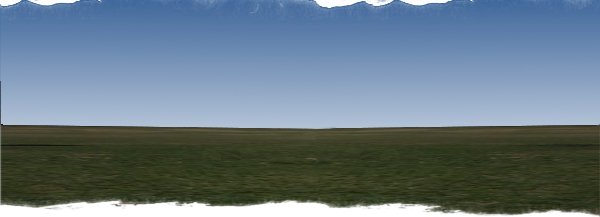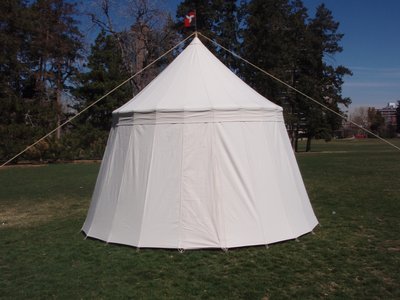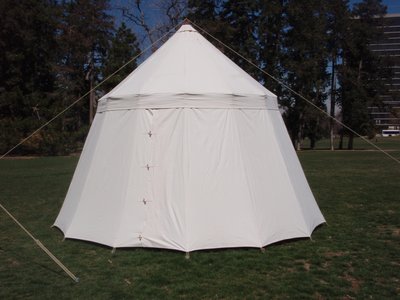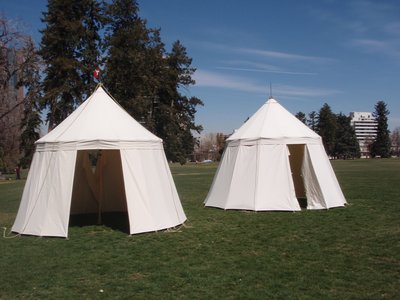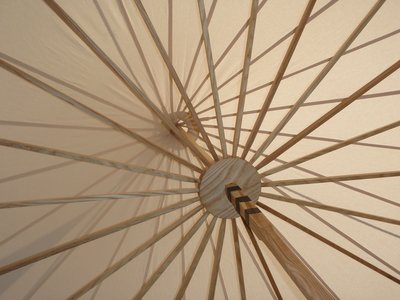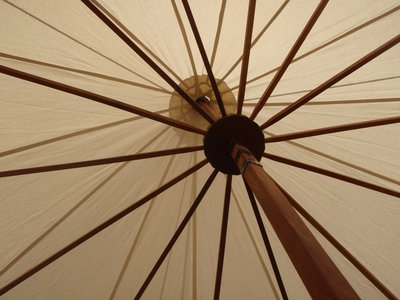Tent Styles
Details
Set-Up Instructions
How wide should the panels be?
What did they do in period?
When ever I have a question about how to do something the answer is usually, "How did they do it in period?" The two extant tents that I know of, have panels that appear to be about 18-24 inches wide. (pics of both on House Greydragon's site)
There are several reasons this might be true.
- Most looms were narrow, therefore wide fabric was more expensive1. This is counter-balanced to some degree by the increased labor sewing seams.
- Seams, being four2 layers thick, are very strong. Thus lots of seams creates an kind of skeleton to carry the tension loads of the tent.
- Being strong, seams make good places to attach stakes and guy lines3. More attachments/stakes make the tent more wind resistant and give it a smoother shape.
It all boils down to cost, strength, and appearance, (and authenticy?4).
How should we do it?
For our purposes, wide fabric is cheap and labor is not, so narrow panels actually cost more. However, the second two points are still quite valid. Considering that any pavilion already represents a considerable investment, I feel that a shorcut that saves a small amount of money but costs both authenticity and strength is probably a false economy.
As an aside, one of the most convincing arguments I've heard against hub and spoke frames for round pavilions is that the result doesn't really look 'round',but has more of a 'faceted' look. This not so good because all of the paintings, woodcuts, etc. do look decidely round. I gave a lot of creedence to this argument, but still used hub and spoke because it works so well. Anyway, I made a tent with panels in the width range of the period examples (19" vs. the 29" I had been using). I set it up, and discovered that it looked round. Yay!
You may be wondering why I use odd numbers like 19" and 29". It's because this minimizes waste. Since even the narrowest fabrics are too wide (36" wide canvas is the narrowest commonly available) and the wide fabric is cheaper per square foot I lay out multiple panels across the width of the fabric. Sunforger canvas is woven 60" wide but is preshrunk to about 58"-59" 3x19 3/8 = 58 1/8. Perfect! No waste.
For rectangular tents (wedges, wall tents, etc.) layout is a bit simpler. I still strongly beleive in keeping stake loops and such on seams and in having plenty of stake loops (since a tent is only as strong as its connection to the ground) I therefore either rip 60" fabric in half and seam it or put in false seams. Either way you end up with seams (and stake loops) about every 27".
Examples
The two tents at left are very close to the same size. At the eaves they are within an inch or two of the same diameter (10'). On the ground there is about 9" difference due to the different slopes of the walls.
The primary difference between the two tents is the width (and thus the number) of the panels. One has 22 panels, the other 14. The difference in appearance is even more pronounced in person than in the pictures.
For more examples, I would encourage you to investigate some the pages under "Inspiration" on my links page. There are a lot of other tents out there. To the best of my knowledge no one else uses panels as narrow as mine.
Notes:
- I have heard this stated, but have my doubts as to it's veracity. Certainly, a larger loom would be more expensive to set up, but once in action, the labor, per square yard of fabric, should be less on a wide loom than on a narrow one. This is certainly true today, and I suspect it may have been true even then.
- Actually... Flat-Felled seams (four layers thick) do not appear to be period, so far as I can tell. However, integral seam stripes (3ish layers) or webbing backed seams are, so the argument is still valid.
- The round tent in Basel actually has false seams in the middle of its wall panels to create reinforced points for stake loops.
- Obviously, while authenticity is a concern for us, it was not a concern at the time.
| |
|
©2009, 2010, 2011, & 2012 Gene Eisele
Privacy Policy
Contact Me
|

